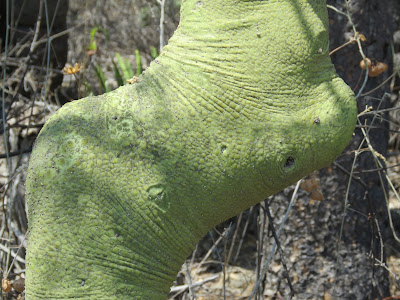Greasy green trunk a bonus in the Mexican desert
Green trunks and stems are handy if you're a plant that drops its leaves during the sunniest months or, like a cactus, you have spines instead of leaves. That way you can - if you are a plant - us the abundant energy from the sun to produce food without those troublesome appendages that lose water so easily.
My example today is the elephantine skinned, Sonoran Palo Verde: the green(verde)-sticked(palo) plant from the Sonoran Desert. Now I haven't visited the Sonoran Desert in Arizona but I have seen this plant growing in central Mexico, near Tehuacán.
Parkinsonia praecox has gathered up quite a few scientific names over the years but it's enough to know it is in the legume family, grouped with Caesalpinia and similar plants. Its natural range extends from the southern Sonoran Desert through Mexico to dryer parts of Peru and Ecuador.
A local common name is Manteco, meaning fat or lard, perhaps a reference to the buttery texture of the bark. Another is Palo Brea, meaning green pitch or tar, probably also a reference to the bark layer, which is a bit like a strip of bitumen. Or both may be because the bark of this tree has been used to tan animal skins into leather.
The resin also has its uses, including an incense sold as Peruvian Gold Copal. You too can experience the 'wonderfully unique notes reminiscent of pumpkin or butternut squash'. Good enough to eat perhaps? And you can. Laboratory tests of mice indicate that at low levels the gum could be a safe food additive.
Palo Verde is the more general name, given to any of the 12 species of Parkinsonia, all with yellow flowers and green bark. In Northern Australia the sharply-spined Mexican Palo Verde, Parkinsonia aculeata, is a problem weed of pastoral land.
The species photographed here was labelled Parkinsonia praecox in the nearby Jardín Botánico Helia Bravo Hollis, a species not, as far as I'm aware, (yet) a weed in this country.
The trees in the botanic garden infected with this beetle, generating a swollen golf-ball sized home on some of the branches. I have read about a dedicated beetle, called the Palo Verde Beetle (Derobrachus geminatus), but that seems to be an entirely different kind of creature whose larvae live in the soil.
And while often (e.g.) described as having an umbrella shape, the trees I saw were relatively young and less expansive in the canopy.







Comments